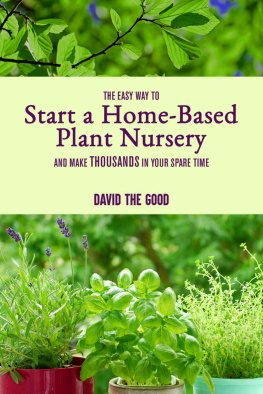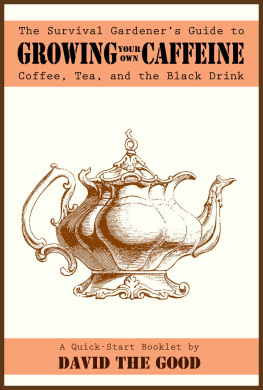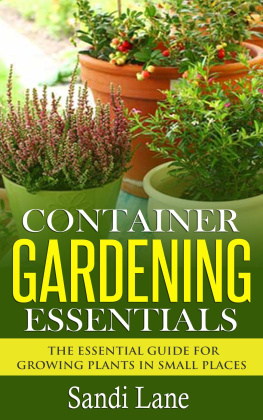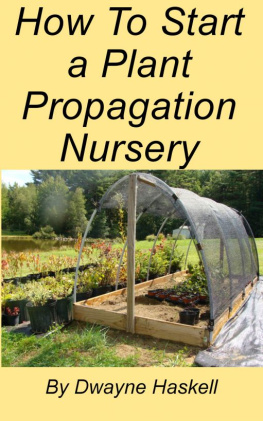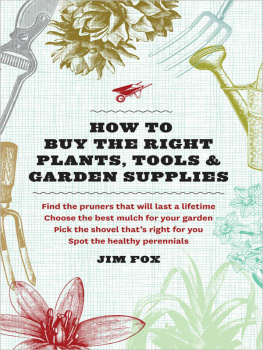How to Start Your Own Nursery
The Easy Way to Start a Home-Based Plant Nursery and Make Thousands in Your Spare Time
David The Good
Copyright
How to Start Your Own Nursery
The Easy Way to Start a Home-Based Plant Nursery and Make Thousands in Your Spare Time
David The Good
Published by Florida Food Forests, Inc.
Florida, USA
This book or parts thereof may not be reproduced in any form, stored in a retrieval system, or transmitted in any form by any meanselectronic, mechanical, photocopy, recording, or otherwisewithout prior written permission of the publisher, except as provided by United States copyright law.
Copyright 2019 by David The Good. All rights reserved.
Version 002
Dedication:
To Dave and Guda Taylor. Thanks for the push.
Introduction
I wrote this book for people who:
Love growing things and want to turn their passion into profit
Want to start a plant nursery but are afraid of failure
Desire to know how I launched my nursery for next to nothing and made almost immediate profits
Want to know how to sell plants
Need extra cash and are willing to work for it
Wish they had an excuse to fill their yard with plants
When I was a kid, I had my own plant nursery. It wasnt particularly legal or profitable, but I loved doing it. I would take cuttings from my grandmothers gardens and beg seeds and bulbs from old ladies. I then planted the cuttings, seeds, and bulbs in pots, grew them up, and had a sale. Along with my younger siblings, I would set up our picnic table in front of our parents house and put out rows of plants for sale.
Thats me at about age 11, sitting behind the table.
Here I am 25 years later at a farmers market:
(Yes, the ladies love a nurseryman.)
For the years in between those photos, I only grew plants for myself and my friends. I would start extra plants and then share them, but I was afraid of the regulations, licenses, and all the complicated stuff I thought was needed to have a legal nursery. Besides, I was working to support a familyI didnt have time for that sort of thing! I loved my gardens and my plants but there was no way I could change careers and go into the nursery business.
A friend, Dave Taylor of Taylor Garden Nurseries in Sparr, Florida, changed my mind.
I would wander around his nursery on a regular basis, asking questions, enjoying the multitude of beautiful blooms and always buying more plants than I should.
You should start your own nursery, he told me. You could get your plants for cheap.
What? I said.
You could go right to wholesalers and get what you want.
Isnt that hard? I asked.
Nah, its just a license and inspection, he said.
Someone else told me the same thing around the same time. Start a plant nursery, Dave. You love plants. You could sell some of what youre growing!
I was still nervous about the idea. Didnt I need expensive stuff, like a greenhouse and irrigation? Wouldnt the government be all over me? What about the accounting? And I was just one guyhow would I get everything done? Would I have to buy land? How would I even find these wholesalers? Would they want to work with a small fry? What about lawsuits? What about
Fear. Fear is the passion killer, the obstacle that holds you back from success. I was afraid of failure and dealing with regulations and people. In retrospect, I was a total wuss.
I didnt give up on the nursery idea, though. Instead of jumping right in or quitting the idea completely, I asked Dave and his wife, Guda, to hold my hand.
Not literally, of course. Dave would have punched me out, and Guda would have rolled her eyes. What I needed was a mentor, so I asked Dave if I could volunteer one day a week at his nursery and learn. They graciously agreed to let me help, and after a few months, I had learned plenty. I helped pot plants, fertilize, shovel potting soil, deal with customers, and set up multiple plant shows. It was hard work, but it gave me enough confidence to jump out on my own.
In this book, I will do the same for you. You dont have to be afraid. You wont fail. Ill make sure you get your nursery started and running without debt, without much in the way of expenditures, and without the complicated stuff you see at big commercial nurseries. Within a few months of starting my nursery, I was making a few hundred bucks a week in cash working about twelve hours a week. If I had gone full-time, I would have made morebut even cutting down to eight hours a week would have more than paid for my time and covered a few bills along the way.
This isnt a guide to setting up a proper nursery with dozens of workers, expensive greenhouses, cloning facilities, and big landscaping clients. This is a book for scrappy backyard bandits with big dreams and little cash.
You can build a profitable plant nursery on next to nothing and have a blast doing it.
Let me show you how.
Chapter 1: Creating Your Nursery Space
Finding and preparing a nursery space doesnt have to be a big deal. I used about eight thousand square feet in my backyard to grow many hundreds of plants. You dont need that much space, either. You can make a profit with just a few hundred square feet.
The main things you need are some sunlight, some way to keep the weeds down, and some irrigation.
Your backyard doesnt have to be a showroom. Most of the time, I didnt have customers in my nursery with some notable exceptions Ill share later. All you need is a decent working space. If youre growing fruit trees and vegetables, youll need full sun. If this requires cutting down a tree, do it. Youll more than replace the value of the tree with your nursery work. However, dont get carried away with the full sun. You might want to grow some shade-loving species or wish you had a cool area to work in the heat of summer. Natural shade from a tree costs nothing, and I much prefer it to building a shade house. Remember, the point is to make money, not spend it on infrastructure!
I like my nursery area to be close enough to my living area and my vegetable gardens that I dont overlook it. If you tuck it in a far corner of your yard, its too easy to overlook drooping leaves or aphid infestations. Keep your plants close.
A concrete slab or patio is a great place to line up your plants. If you dont have that, I highly recommend using a plastic ground cover to create a space for your plants. I used DeWitt Weed-Barrier 20 Year woven landscape fabric.

Its way better than anything you can get from your local hardware store. John Deere sells it, and you can buy it online. All you need to do is mow an area of your backyard, then roll out the fabric and tack it to the ground with metal staples (which you can get at the same time as the fabric). The rolls come in 3, 4, 5, 6, 8 and 12 widths. I used 4 widths to cover my unused garden beds, but for a nursery, 8 is nice to roll down. You can cover a lot of space quickly. Once you mark out your area and roll out the first stretch of fabric, roll out another foot or so and cut it with a razor knife. Then tuck the cut portion underneath the end before you tack it down. That will keep it from unravelling into shreds over time. If youre more clever than me, you could melt the ends together with something but I never tried that.

